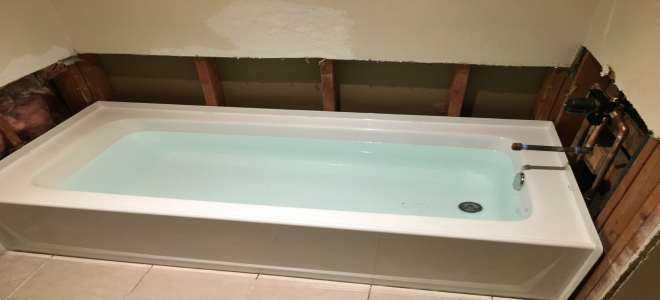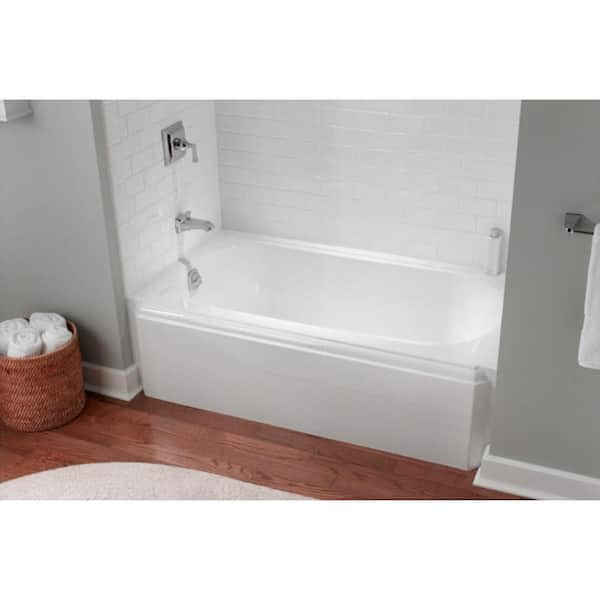Just How to Install a Bath Tub Yourself: Removing as well as Replacing.
Just How to Install a Bath Tub Yourself: Removing as well as Replacing.
Blog Article
What are your opinions about How to Install a Bathtub: Install an Acrylic Tub and Tub Surround?

Installing a tub isn't specifically brain surgery, but it does require solid plumbing, carpentry, and sometimes, tiling abilities. Changing an old bathtub with a brand-new one is likewise a moderately tough task. If the old tub is readily accessible, the job can move rapidly; if you have to open a wall surface to remove the old bathtub as well as position the new bath tub, the job is a lot harder. In either case, the task is within a house handyman's skills, although you will certainly require a helper to vacate the old bathtub and embeded in the brand-new one. Ensure you have certified yourself for the work as well as are comfortable trying it. Instead of hiring a service provider to take over a halfway-completed job, it is better to take into consideration employing one prior to you begin. Opportunities are you may require a professional plumber to make tube links.
This short article will certainly assist you mount a new tub in your bathroom if you have currently bought a new bathtub and don't require to change the setup of your previous water supply pipelines.
Your devices and product list ought to comprise the following:
Preparing for the Setup
To start with, the supporting framework provided with the bathroom should be fitted (if needed) according to the supplier's instructions. Next, fit the taps or mixer to the bath tub. When suitable the faucet block, it is important to ensure that if the faucet comes with a plastic washer, it is fitted in between the bathroom and also the taps. On a plastic bath, it is likewise practical to fit a sustaining plate under the faucets unit to prevent stress on the tub.
Fit the adaptable faucet adapters to the bottom of the two taps using 2 nuts as well as olives (sometimes supplied with the tub). Fit the plug-hole outlet by smearing mastic filler round the sink outlet hole, and after that pass the outlet via the hole in the bath. Utilize the nut supplied by the manufacturer to fit the plug-hole. Check out the plug-hole outlet for an inlet on the side for the overflow pipeline.
Next off, fit the end of the flexible overflow pipe to the overflow electrical outlet. Afterwards, screw the pipeline to the overflow face which should be fitted inside the bathroom. Ensure you use every one of the supplied washers.
Attach the trap to the bottom of the waste outlet on the bathtub by winding the string of the waste outlet with silicone mastic or PTFE tape, as well as screw on the trap to the electrical outlet. Connect the bottom of the overflow tube in a comparable manner.The bath must now prepare to be suited its final placement.
Removing Old Taps
If you need to change old faucets with new ones as a part of your installation, after that the first thing you must do is separate the water system. After doing so, switch on the taps to drain any kind of water staying in the system. The process of removing the existing faucets can be rather problematic due to the limited gain access to that is typically the case.
Make use of a basin wrench (crowsfoot spanner) or a tap device to undo the nut that connects the supply pipes to the faucets. Have a fabric ready for the continuing to be water that will certainly originate from the pipes. Once the supply pipelines have actually been eliminated, utilize the same device to loosen up the nut that holds the taps onto the bath/basin. You will certainly require to stop the solitary taps from transforming throughout this procedure. When the faucets have been eliminated, the holes in the bath/basin will have to be cleaned up of any kind of old sealing compound.
Before proceeding to fit the new taps, compare the pipeline links on the old faucets to the brand-new faucets. If the old faucets are longer than the brand-new taps, after that a shank adapter is required for the new taps to fit.
Mounting the Bath tub
Using both wooden boards under its feet, place the tub in the needed position. The wood boards are helpful in evenly spreading the weight of the bath tub over the area of the boards as opposed to focusing all the weight onto four little factors.
The next goal is to make sure that the bath tub is leveled all round. This can be achieved by inspecting the level and also adjusting the feet on the bathtub up until the spirit level checks out degree.
To mount taps, fit the bottom of the furthest versatile faucet connector to the suitable supply pipeline by making a compression join; then do the exact same for the various other tap.
Turn on the water supply as well as examine all joints and also new pipework for leaks as well as tighten them if essential. Fill the tub and likewise examine the overflow electrical outlet and the typical electrical outlet for leakages.
Finally, repair the bathroom paneling as defined in the manufacturer's instruction manual. Tiling as well as securing around the bath tub should wait up until the tub has actually been made use of at least once as this will settle it into its final position.
Fitting New Taps
If the tails of the brand-new faucets are plastic, after that you will need a plastic adapter to avoid damage to the string. One end of the connector fits on the plastic tail of the faucet and the other end offers a connection to the current supply pipelines.
If you require to fit a monobloc, after that you will require minimizing couplers, which links the 10mm pipe of the monobloc to the common 15mm supply pipe.
Next, place the faucet in the placing opening in the bath/basin guaranteeing that the washing machines remain in area in between the faucet as well as the sink. Protect the faucet in place with the manufacturer given backnut. When the tap is safely in position, the supply pipelines can be connected to the tails of the taps. The faucets can either be attached by utilizing corrugated copper piping or with regular tap connectors. The former type should be linked to the tap finishes initially, tightening up just by hand. The supply pipelines can later on be linked to the various other end. Tighten up both ends with a spanner after both ends have been connected.
Tiling Around the Tub
In the area where the bath meets the tile, it is required to secure the joins with a silicone rubber caulking. This is very important as the fitting can relocate sufficient to crack a rigid seal, triggering the water to pass through the wall between the bath as well as the tiling, leading to issues with wetness and feasible leakages to the ceiling below.
You can select from a range of coloured sealants to blend in your components and also installations. They are marketed in tubes and cartridges, and are capable of sealing gaps up to a width of 3mm (1/8 inch). If you have a bigger gap to load, you can load it with spins of drenched paper or soft rope. Remember to constantly load the bath tub with water prior to securing, to enable the motion experienced when the tub remains in usage. The sealer can crack fairly early if you do not consider this movement prior to securing.
Alternatively, ceramic coving or quadrant tiles can be used to border the bath or shower tray. Plastic strips of coving, which are easy to use and also reduce to size, are also conveniently available on the marketplace. It is recommended to fit the tiles making use of water-resistant or waterproof sticky and cement.
Bathtub Installation
How Important Is A Bathtub To Your Home?
High-quality baths, showers, and other bathroom updates are necessary when considering a smart investment in your home. It’s a room that you go to every day and one that is constantly being used by guests.The bathroom is one of the top trafficked rooms in a home and also one of the most valuable in terms of home resale.
Install Piping Before Tub
You will be using your existing drain and waste vent system, but pipes required include the hot and cold water supply lines and a pipe leading to a shower head. A mixing valve and shower head are also needed. Air chambers may be required.
Position the Tub
Lower the tub into place so that the continuous flange fits against the wall studs and rests on 1’x4' or 2’x4' supports. Anchor the tub to the enclosure with nails or screws inserted through the flanges into the studs.
NOTE: Remember, bathtubs and shower stalls may require support framing. A bathtub filled with water is extremely heavy, so check building codes and framing support before installing the tub.
Assemble Drain Connections
Assemble the bathtub drain connections by connecting the tub overflow with the tub drain above the trap, not beyond it. The trap will have a compression fitting that screws over the arm of the overflow assembly.
Place a Pipe For the Shower Head
First, locate a brass female threaded winged fitting and attach it to a framing support via a screw or a nail. Then run a pipe up the wall for the shower head. Sweat or solder the other side of the brass fitting to the top of the pipe.
Attaching Hot and Cold Water Lines
Attach your water lines for both hot and cold by sweating these directly into the hot and cold ports of the mixing valve. The mixing valve will be how water enters the tub’s system, not by the pipes themselves.
Install the Spout
Extend a piece of 1/2 inch pipe, or whichever length is specified in the manufacturer’s instructions, for the tub spout. Sweat on a male threaded fitting at the end of the pipe or use a brass nipple of the proper length and a 1/2 inch cap.
NOTE: At this point you should have your rough-in plumbing work inspected before proceeding further.
Check For Leaks
Restore the water pressure and check the drain connection and the supply pipes for any sign of leaking.
estore the Bathroom Wall
Replace the wall with moisture-resistant drywall as a base for your wall covering. Seal the joints between the wall and your new tub with silicone caulk as protection against water seepage.
https://www.berkeys.com/2016/12/02/bathtub-installation-dallas/

Do you really like more info about A Step-by-Step Guide to Installing a Bathtub? Create a comment down the page. We will be pleased to listen to your insights about this blog posting. Hoping that you visit us again in the future. Sharing is good. Helping people is fun. Many thanks for your time. Visit us again soon.
This Post Report this page